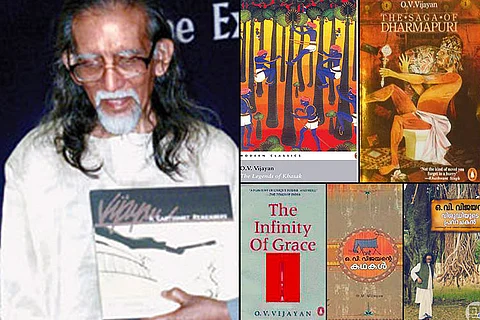

Magic realism is often associated with Latin American Literature. Ask anyone about the proponents of this fantastic style of writing and names like Gabriel Garcia Marquez, Jorge Luis Borges and Salman Rushdie will be the ones you would hear. A name that is often left out or even unknown to the lovers of magic realism is Ottupulackal Velukkuty Vijayan or OV Vijayan.
Magic realism is defined as a literary or artistic genre in which realistic narrative and naturalistic technique are combined with surreal elements of dream or fantasy. It is also referred to as Fabulism owing to the usage of fables, myths and allegories.
OV Vijayan was born in 1930 in Palakkad district in Kerala. A sickly child, who mostly stayed indoors in the early years of his life, he started formal schooling at the age of 12 and eventually went on to graduate from Victoria College and obtain a Master’s Degree in English Literature from Presidency College, Madras.
Kerala is a land filled with folklore, myth and dark humour. I surmise that as a child he grew up listening to these stories and it had an effect on his writing style and form.
The book that brought him wide recognition was definitely Khasakinte Ithihasam or The Legends of Khasak, which was published in 1969, just two years after Gabriel Garcia Marquez’s seminal work – One Hundred Years of Solitude. It took Vijayan 12 years of writing and rewriting to give the book its final shape.
The novels of Marquez and Vijayan have certain similarities. Both are set in fictional towns (Macondo in the case of Marquez and Khasak in Vijayan’s case) where occult and supernatural practices are part of the people’s daily lives. These are worlds where magic and folklore merge seamlessly with reality or the very perception of it. The Legends of Khasak was a landmark book. So popular was the book that it irrevocably split Kerala literature into pre-Khasak and post-Khasak phases.
I was introduced to the writings of OV Vijayan much later in my life when one of my Malayali friends suggested I read him. He was appalled that I had not heard of this stalwart or read any of his works. Owing to the fact that I have lived all over the country I was never really comfortable or proficient in reading Malayalam. I started with the English translation of Khasakinte Ithihasam and was completely blown away by the writing. It was reminiscent of Marquez and Rushdie.
It tells the story of Ravi who arrives at Kooman Kavu to teach at the district board’s school and thus begins his spiritual journey. Plagued by the guilt of an illicit affair, Ravi comes to this small village to find solace but instead gets engulfed by the fables of that ancient land. Vijayan creates the world of Khasak, which is a magical and wondrous place filled with imperfections. The multitude of characters, the complex storylines drifting between fantasy and reality leaves a lasting impression. It is a book that one will not forget in a hurry.
OV Vijayan’s work was intensely political as well. The Saga of Dharmapuri is a powerful political allegory. It tells the story of a power-hungry, greedy President, who is portrayed throughout the novel as eating, defecating or fornicating. It is evident that the President is only interested in appeasing the needs of his own body and cares very little for the welfare of the people. To save the people of Dharmapuri from their oppressive, racist President comes the mystic Siddhartha. This book managed to ruffle a few feathers and was briefly withdrawn under Indira Gandhi’s regime.
It was Gurusagaram (The Infinity of Grace), a novel which is a spiritual odyssey into the human psyche, that won him the Sahitya Akademi Award and is probably his most accessible novel.
A prolific cartoonist as well, Vijayan worked for publications such as The Hindu and Statesman to name a few. His works also appeared in The New York Times and the Far Eastern Economic Review. His searing commentary on Indira Gandhi’s return to power in the 1980s remains a high point of cartooning in India.
OV Vijayan was a master writer, cartoonist, political commentator and a complex human being. With a blend of myth, dark humour, eroticism and fantasy, he created a uniquely Indian brand of magic realism. He is an Indian author who definitely needs to be read by more people.
Note: If you want to start reading the English translations of OV Vijayan, a book titled OV Vijayan: Selected Fiction published by Penguin is a great place to start. The book includes The Legends of Khasak, The Saga of Dharmapuri and The Infinity of Grace, in addition to 21 short stories.